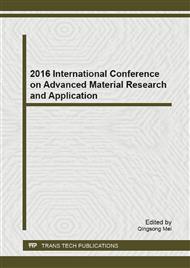p.57
p.62
p.71
p.75
p.79
p.85
p.93
p.101
p.107
Preparation and Luminescent Properties of 0.1%Ce3+:BaF2 Laser Ceramics by Vacuum Sintering
Abstract:
0.1% Ce3+:BaF2 powders were prepared by coprecipitation method. Then the transparent ceramics were prepared by vacuum sintering. The effectts of sintering temperature and holding time on transparent ceramics were studied. The results show that the 0.1% Ce3+:BaF2 powders prepared by coprecipitation are approximately spherical with the size ranging from 200~300nm and good dispersion. The maximum light transmittance of the 0.1% Ce3+:BaF2 transparent ceramics reaches 69.2% when the sintering temperature is 1275°C. The fluorescence intensity of the transparent ceramics enhances with the increase of the sintering temperature. There are two characteristic f-f transition emission peaks at 610nm and 650nm when the excitation peak is at 290nm. The maximum transparency of 71.4% emerges when the holding time is 6h at 1275°C and the fluorescence intensity reaches the maximum. The 528nm (5D1→2F7/2) appears when excitated by the 524nm excitation light.
Info:
Periodical:
Pages:
79-84
Citation:
Online since:
January 2017
Authors:
Price:
Сopyright:
© 2017 Trans Tech Publications Ltd. All Rights Reserved
Share:
Citation:


